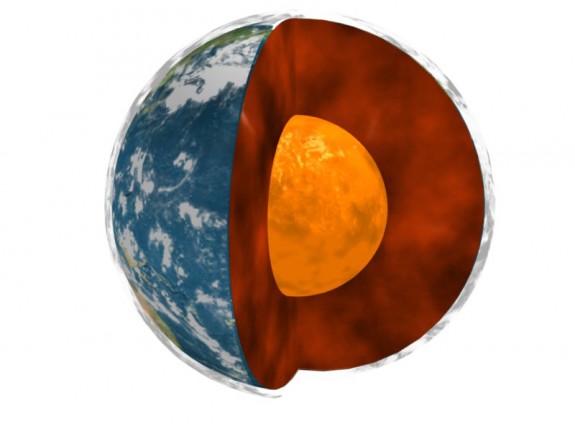The Center of the Earth Is as Hot as the Sun
1,800 degrees warmer than we previously thought, the Earth’s core is super hot

Photo: NASA
Crushed by the weight of the thousands of kilometers of liquid iron and sulfur, superheated metal and minerals and cool crustal rock above, the Earth’s core is under immense pressure. Heated from within by friction and by the decay of radioactive material and still shedding heat from the initial formation of the planet 4.5 billion years ago, the planet’s core is blisteringly hot. In new research, scientists studying what the conditions at the core should be like found that the center of the Earth is way hotter than we thought—around 1,800 degrees hotter, putting the temperature at a staggering 10,800 degrees Fahrenheit.
This superheated core, says the BBC, is about as hot as the surface of the Sun.
Scientists know the Earth’s core, a multi-layered structure with a solid iron core spinning in a sea of liquid iron and sulfur, is hot. But, cut off from direct study by all the stuff in between the core and the surface, getting an accurate idea of the core’s properties is a daunting feat.
Led by Simone Anzellini, the French research team did their best bet to reproduce the core’s properties in the lab: they took a bunch of iron and crushed it between two pieces of diamond. Then they shot it with a laser. The apparatus produces massive pressures and superheated temperatures. This let them study how the iron behaved under such intense conditions and gave them a window into the conditions found at the planet’s center.
Knowing how hot the Earth’s core is can add to our understanding all sorts of wonders, from the existence of the planetary magnetic field, to the propagation of seismic waves after an earthquake, to the birth of the Earth itself.
More from Smithsonian.com:
10 Things We’ve Learned About the Earth Since Last Earth Day
New Project Aims to Drill to the Earth’s Mantle, 3.7 Miles Down
/https://tf-cmsv2-smithsonianmag-media.s3.amazonaws.com/accounts/headshot/smartnews-colin-schultz-240.jpg)
/https://tf-cmsv2-smithsonianmag-media.s3.amazonaws.com/accounts/headshot/smartnews-colin-schultz-240.jpg)